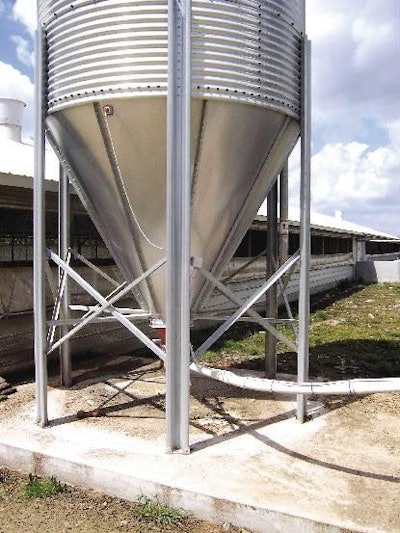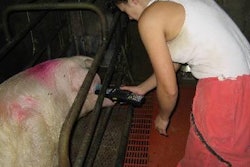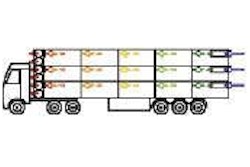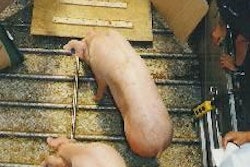
A research report published in the USA suggests that feed shortages are an increasing problem on American nursery and grow-finish facilities. Referring to the shortages as out-of-feed events, it says some of them are due to the mechanical failures suffered occasionally by any system for distributing feeds to pens. But it also points to additional disruptions due to human error affecting a delivery into the bulk storage silo and to the age-old difficulty of materials becoming bridged or stuck inside a bin so they do not flow to the out-take conveyor as desired.
More instances of bridging are being reported, the annual Swine Report from the University of Nebraska comments, as producers continue to reduce the fineness of grind for their complete diets in order to improve feed conversion. In addition to the obvious implications for pigs' potential growth, the absences of feed resulting from bridging and other factors are a known cause of ulcers in pigs and are suspected of having links to an increased incidence of the haemorrhagic bowel syndrome and ileitis.
But the investigators in Nebraska wanted to check particularly on the longer-term consequences for growth performance from feed breaks on a unit with nursery and grow-finish places. Their earlier work, described in the university's 2006 Swine Report, had found indications that the impact of an out-of-feed event could be greater for the growing pig than for one in the finishing phase of production. Testing in that instance had been of a period of 20 hours without feed on a random day in each week of a 16-week trial. Virtually all of the reduction in weight gain recorded for the full trial related to the first 8 weeks.
Subsequently the examination has been widened to cover the more likely scenario in practice, involving temporary interruptions of the feed supply to pigs on varying occasions in their growing and finishing stages. The out-of-feed events were again staged to occur between midday and 08:00 the next day. Starting 37 days after weaning at 14-21 days old and extending for another 16 weeks, experimental groups had their feeder closed for these 20 hours up to 3 times every 2 weeks.
Once more, it seemed that the sensitivity of the pigs to intervals without feed was age-related. A linear relationship between feeder closures and growth response was detected only in the first 8 weeks of the trial. During that period, daily gain decreased in line with the increasing number of occasions on which feed supplies had been interrupted. Afterwards, however, growth showed no link to the number of out-of-feed events. Measurements across the full duration of the trial did not establish any effect on feed conversion or within-pen variability.
A more revealing pattern appeared when the researchers looked at feed intake patterns after feed supplies had been restored. Clues in this direction had already been seen in the 2006 work. Then, pigs missing feed on a random day each week increased their intakes by 14% in the first 24 hours following restoration during the first 8 weeks of the trial. But this increase soared to 42% in the second 8-weeks period. The testing described by the 2007 Nebraska Swine Report found that in the first 8 weeks even the most affected pigs (those having 2-3 intervals without feed every 2 weeks) responded by eating just 11-18% more in the next 24 hours. The following 8 weeks saw the equivalent groups adding 22-28% to their daily feed intake.
So the take-home message must be that you cannot expect growing pigs to compensate as much as finishing-stage animals for any temporary interruption in their feed supply. Speculation offered by the Nebraska team focuses on the capacity of the pig for taking in more feed. Perhaps the younger animal's normal appetite is close to the maximum it can eat at any one time. As it ages, on the other hand, intake comes under the influence of a variety of factors and may be increased quite strongly in the short term to compensate for a previous feed-free period.
The scale of the potential impact at growing-pig level remains to be determined, however. The team observes that its out-of-feed events were rather regular for duration and therefore were possibly less influential than a sequence varying in length. Moreover, the timing of the events through the afternoon and at night did not correspond to an accepted view of pigs' normal eating behaviour beginning around 06:00 and peaking at 14:00. On this basis, the experimental groups may have eaten before the feed break happened so that their response to it was less than if it had occurred, say, in the morning hours.
Nevertheless, there was a clear bottom-line result from the Nebraska testing. Fail to have feed in the bin or to extract it when required, this has indicated, and you will be risking a major drop in growth. Pigs in the trial that had an uninterrupted access to feed gained approximately 840 grams weight per day over the initial 56 days, in growing from about 18kg to 65kg liveweight. Those missing 3 feeding opportunities each 2 weeks over the same period managed only about 754g/day.
They were unable to eat enough to make up for lost ground once the feed supply was resumed.





.jpg?auto=format%2Ccompress&fit=crop&h=167&q=70&w=250)











